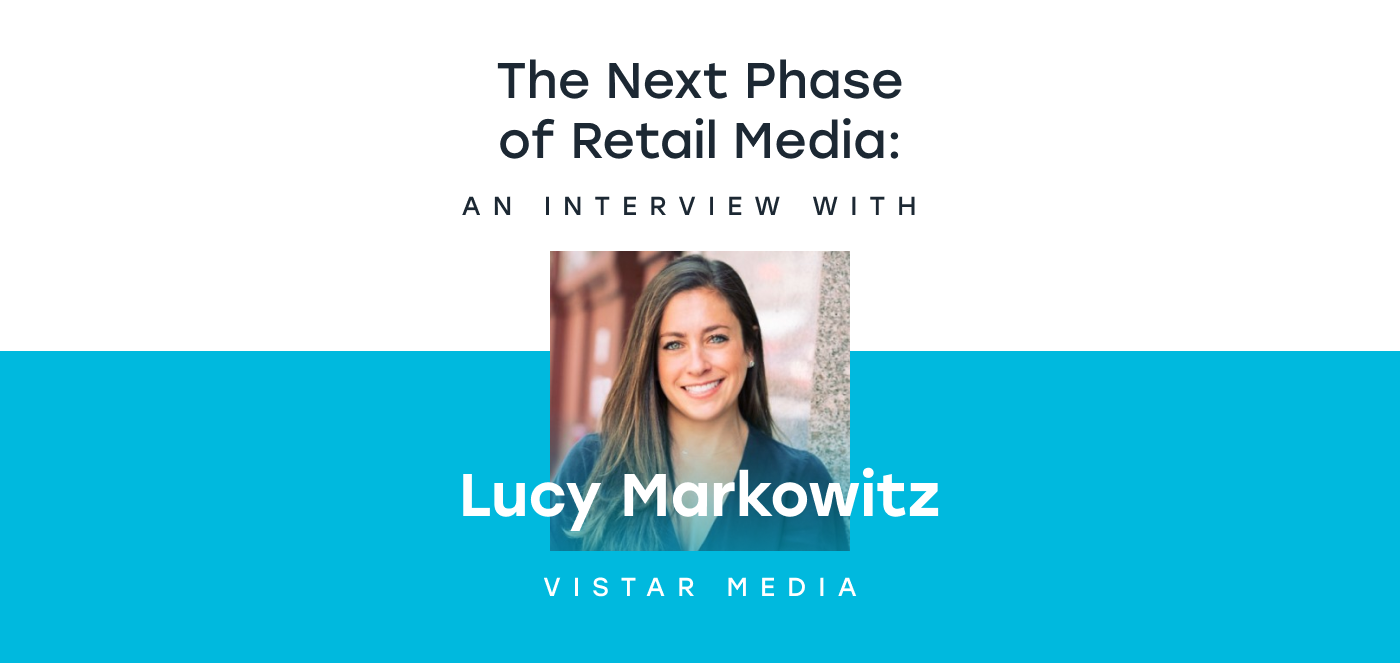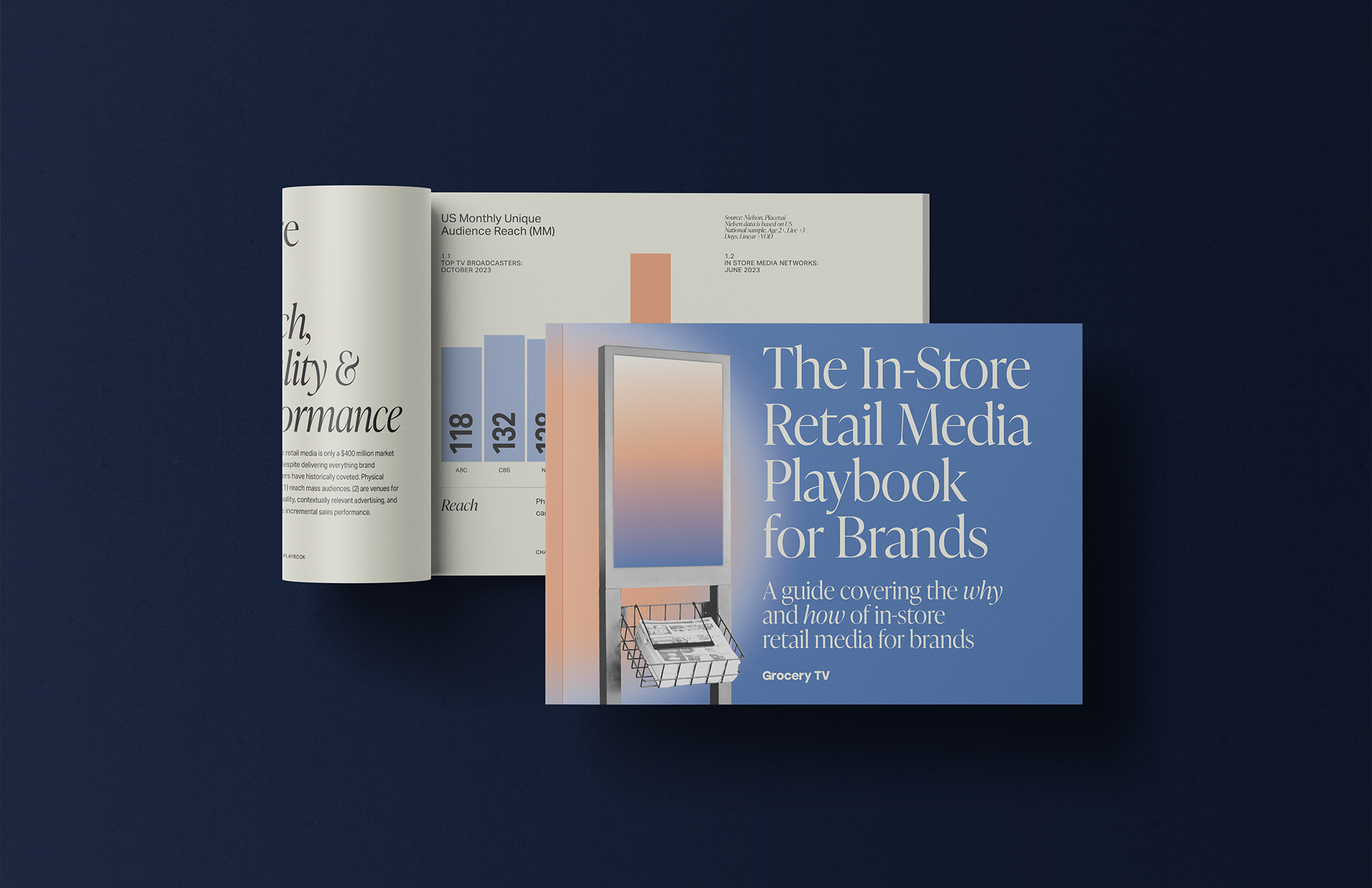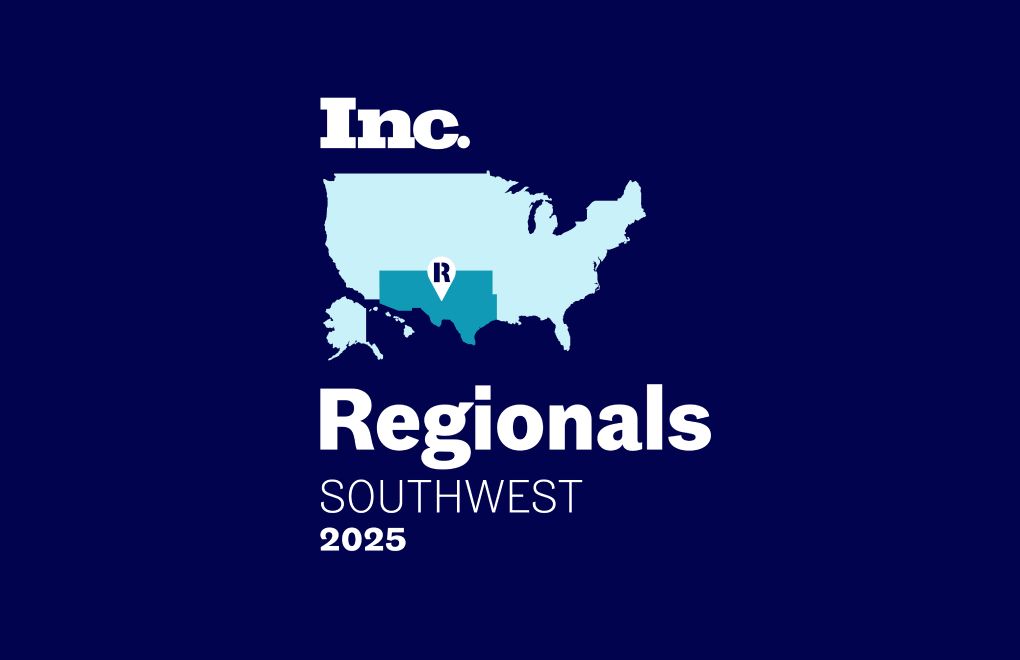When the pandemic began, we saw retail media gain traction within eCommerce and online advertising due to shifts in consumer behavior and the overall retail landscape. Advertisers and retailers realized that having a strong digital presence was necessary in order to stay competitive, but how should we think about brick-and-mortar touch points?
Although online channels are crucial to any retail media strategy, it’s important to keep in mind that consumers continue to value the in-person shopping experience.
We recently interviewed Lucy Markowitz, Senior Vice President of U.S. Sales at Vistar Media, to dive further into the relationship between in-store advertising and retail media. Lucy discusses digital out of home’s (DOOH) role in retail spaces, tracking campaign performance, in-store advertising within omnichannel campaigns, and much more.
First off, what makes retail media so important to advertisers today?
More than 70% of purchases are still made inside of a physical store, and retail media gives advertisers the opportunity to reach their target audience while they’re in the shopping mindset / at the point of purchase.
This keeps brands top of mind, influencing purchase decisions in real-time. Online advertising is often in over-saturated contexts, whereas customers are receptive to viewing retail media screens and DOOH in the physical environment.
Vistar has talked a lot about the value of DOOH in retail spaces. How do you see in-store advertising working as a form of retail media?
Many retailers are leaning into in-store advertising, with screens being placed throughout stores in strategic ways that enhance the customer experience. This might be digital screens added to kiosk tops, checkout aisles, shelving units, and more— even the audio ads you hear are a format of DOOH and in-store advertising.
We believe retailers will look to create in-store experiences that extend, and effectively complement, their customer communication platform in addition to their app, website direct mailers, new circular, and email communications.
In-store advertising should be an extension of all the other strategies brands use to keep top-of-mind during the critical purchasing window, just like product packaging, shelf placement, app messaging, etc.
Can in-store retail media work for both endemic and non-endemic brands? In what ways?
Most definitely, they can both benefit from retail media. Endemic brands can take advantage of reaching their target audience while they’re at the point of purchase.
They might target loyalists and existing customers, or take a competitive conquesting strategy by targeting consumers who frequently purchase competing products. In-store advertising for endemic brands can almost be seen as an extension of shelving strategies and other tactics to influence basket additions.
On the other hand, non-endemic brands will look to target consumers at multiple locations as they move throughout their day. Most consumers visit retail locations with some frequency, so in-store advertising provides a perfect touchpoint to complement billboards, transit, office buildings, radio, or other messaging avenues.
Similarly, many consumers go on to visit multiple locations after visiting a retail store, providing a perfect opportunity for influencing site visits and foot traffic.
Every retailer will have their own rules and regulations, but Vistar makes it easy for the retailer or screen operator to approve and deny any creatives/campaigns. This allows for any competitive product placement restrictions that may be required.
What parts of the marketing funnel can in-store retail media ads influence?
All parts of the funnel are influenced by in-store retail media. It depends on the goal of the DOOH campaign, but in-store retail media is a great way for brands to see an increase in:
- • Brand awareness, which alerts customers to a new product in a category or conquest against a competitive brand
- • Foot traffic, which drives visits to a location customers may visit while they’re out running errands
- • And sales lift, which influences decision-making at the point of purchase and increases basket size
For example, an optical retailer partnered with us to drive foot traffic to its store locations across Australia. We implemented proximity targeting to activate DOOH media across several venue types, including grocery stores and shopping centers, near the retailer’s store locations throughout multiple cities, and triggered media more frequently to optimize ad delivery.
As a result, we were able to help the optical retailer drive consumers down the funnel, resulting in a 7% increase in foot traffic in-store. Consumers exposed to the DOOH campaign at shopping centers were more likely to visit the stores, demonstrating the positive impact of activating media in a contextually relevant setting.
Another example is the work we did with a healthcare institute to increase awareness, consideration, and purchase intent for its new blood glucose monitoring product. By targeting a custom audience segment and analyzing the audience’s movement patterns, we were able to activate DOOH media across a variety of venue types, including grocery stores and pharmacies, with the added layer of proximity to key Walgreens and Walmart retail locations.
Weather targeting was also utilized to deploy campaign messaging when diabetes symptoms and prescription triggers were activated. This generated a 12% lift in awareness, 21% lift in consideration, and 45% lift in purchase intent for the product.
How is campaign performance currently being tracked for in-store advertising, and how do you see that changing in the future?
There are plenty of measurement offerings available today that can tie actual exposure to a DOOH campaign - including across in-store media - to relevant KPIs for advertisers.
This includes:
- • Brand studies with panels to evaluate lift in awareness
- • Foot traffic to compare rates of visitation from the people that saw an ad in-store to those that didn’t and analyze the behaviors of people that saw the ad in the retail environment
- • And sales lift to tie exposed consumers to household purchase data
How targeted can you get when advertising in physical locations? Will the decline of third-party data affect in-store targeting?
Campaigns can get very targeted. Advertisers can combine a retail media strategy with audience-driven buying to only run in the exact times and locations where your audience is likely to be, or focus on retailers within a certain geographic location or DMA.
Additionally, they can precisely align messaging to deliver at specific locations aligning with product launches, promotional offerings, and more. So far, we haven’t seen a significant impact on data availability for targeting.
Retargeting is a key strategy for advertisers that use retail media online. How can they approach this in physical retail?
Brands that use DOOH to advertise can execute mobile retargeting to re-engage shoppers exposed to DOOH on their mobile devices. Whether a brand is activating DOOH on the path to purchase or at the point of purchase, or both, they can add in that strategic additional touchpoint with the consumer.
In addition to mobile retargeting, Vistar has a Device ID passback solution that provides the ability to, in a privacy-safe environment, identify consumers who were exposed to a brand’s DOOH campaign and pass the anonymized device IDs to the brand’s preferred omnichannel DSP.
This allows them to retarget among any other channel of the client’s choice (including CTV, streaming audio, online video, etc.). To really stay top of mind, they can also think about activating audio OOH to reach consumers by ear while they are shopping in-store.
Do you have specific examples that showcase the impact of using in-store advertising in omnichannel campaigns?
One example of in-store advertising is work we did with a prominent cold and flu medication to drive awareness, consideration, and purchase intent for its product to ultimately increase store visits to key retailers and drive sales.
The campaign leveraged purchase data to build an audience of current and competitive consumers, and also activated cold and flu weather triggers (via our partnership with IBM’s WEATHERfx) to reach consumers with DOOH media when associated weather conditions spiked. Additionally, the strategy included proximity targeting to reach consumers when they were close to key retailers carrying the product, such as CVS and Walgreens.
The campaign ran across both path-to-purchase and point-of-purchase DOOH inventory - including billboards, grocery stores, pharmacies, and transit stations - and re-targeted to consumers with proximity to DOOH screens on their mobile devices for re-engagement with the campaign and brand.
As a result, the campaign generated a 10.3% lift in product sales, 23% increase in purchase intent, 21% lift in consideration, and 2% lift in awareness, with cross-screen exposure driving the strongest impact on purchase intent and consideration— showcasing the power of leveraging both DOOH and mobile media to drive consumers down the funnel.
Where do you see room for improvement when it comes to leveraging in-store media in advertising campaigns?
Brands should invest in compelling content that aligns with the environment and work more closely with their teams to develop dedicated creative for OOH beyond a traditional billboard and implement relevant messaging— whether that's customized by contextual location of the venue type, time of time, day of the week, or relating to local weather conditions.
Brands should also consider coupling their audio OOH strategies with their digital OOH strategies to reach consumers multiple times when they’re in the store at the point of purchase.
As mentioned before, brand teams need to work closely together to align their different in-store marketing strategies. Oftentimes today, these different elements are living with different teams and there’s an opportunity for additional cross-team collaboration and more strategic planning. There’s a great opportunity here.
Lastly, what do you think retail media will look like 5 years from now?
In 5 years, retail media will be bigger than ever before. There will be more digital signage screens in retailers, providing brands with the opportunity to reach their target audience at multiple different touch points throughout their shopping experience, and more advertisers will leverage retailers’ first-party data and third-party data.
Today, many retailers still treat in-store advertising as a bit of an afterthought, but increasingly the most advanced are starting to revisit their approach. Digital signage has the ability to transform an in-store experience by providing relevant content and services to consumers, additional messaging touchpoints for brands and ultimately driving more revenue for retailers.
As these key physical locations embrace new signage opportunities, our entire industry will benefit.
Stay tuned for more insights
We’d like to thank Lucy for taking the time to share her thoughts about the state of retail media and how it’s evolving in stores. We’re excited to continue the conversation with more industry leaders here on our blog!
Is there something you’d like to learn more about when it comes to retail media or DOOH? Feel free to reach out— we’d be happy to chat.
Connect with us



![[Report] In-Store Retail Media: The Key to Driving Incremental Reach for Brands](/content/images/2025/05/GTV-Incremental-Study-1.jpg)
